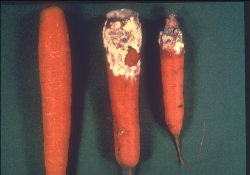
The use of Signum in a programme has been shown to reduce the levels of both major and minor storage diseases in carrots. With Sclerotinia being a problem this year, the integration of this protectant fungicide will lower the risk of this disease infecting the roots as they go into store. In addition, work from Holland shows that Signum reduced the levels of other storage diseases, producing a more marketable sample following storage, according to BASF.
"Black spot (or liquorice rot) in carrots, caused by Mycocentrospora and Chalaropsis, results in unacceptable samples and reduced marketability. The prevention of potentially high losses starts in the field through an effective, robust programme of protectant fungicides, which also protects against other more frequent foliar diseases," advises Dave Marris, Field Vegetable Product Manager for BASF.
In trials carried out in Holland, carrots were stored for four months and then assessed for root infections. The untreated showed 31% of infected roots. Signum resulted in just 9% infection which was significantly better than azoxystrobin with 15% of infected roots.
"Sclerotinia is a serious problem in carrots, with the disease being active since mid-August and the wet summer being favourable for further infections. The pathogen can infect roots via the leaf petiole through the crown and during storage the roots become soft and watery and covered in a white mycelial growth. Recent wet weather has also been just right for Alternaria development. Growers are advised to monitor their crops and apply Signum in order to minimise problems in store," advises Dave.
"Signum has been shown to outperform other fungicides in the control of the major diseases of carrots, namely Sclerotinia, Alternaria and powdery mildew as well as being active on some minor diseases such as Cercospora and other storage complex diseases. Two applications of Signum can be made to each crop and it is important that it is integrated into a programme with other non-strobilurin fungicides, in order to minimise resistance risk," reminds Mr. Marris.
